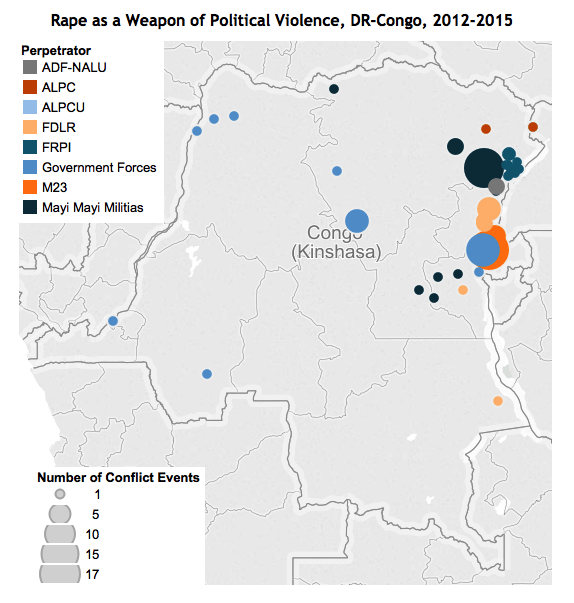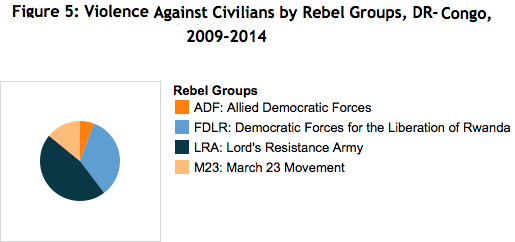Dynamic Conflicts and Static Promises: Shifting Advantage, the Political Marketplace and Broken Ceasefires
13 March 2015
In the past half-decade, multiple peace agreements and ceasefires have been implemented in various African countries to solve ongoing political conflicts on the continent. The most notable examples during this period are Mali, Central African Republic and South Sudan. In spite of direct engagement from the international community as mediators, and often-willing participation in negotiations…
Read MoreRape as a Weapon of Political Violence, Part 2: Where, When, and by Whom is This Tactic Used?
25 February 2015
Sexual violence (e.g. rape) is a conscious strategy frequently employed by armed groups to torture and humiliate opponents, terrify individuals, destroy societies though inciting flight from a territory, and to reaffirm aggression and brutality, specifically through an expression of domination (Bastick et al., 2007; UN, 2015). In order to torture opponents, sexual violence can be…
- Africa
- Civilians At Risk
- Current Hotspots
- Ethnic Militias
- Focus On Militias
- Gender-Based Violence
- Inequality
- Local-Level Violence
- Political Stability
- Unidentified Armed Groups
- Vigilante Militias
- Violence Against Civilians
Rape as a Weapon of Political Violence, Part 1: Trends Across Africa
18 February 2015
Sexual violence as a weapon of political conflict is a serious, present-day atrocity affecting millions of people (primarily women and girls)[1] with grave health implications, both physical and psychological (Bastick, Grimm, and Kunz, 2007; UN, 2015). It is frequently a conscious strategy employed by armed groups to torture and humiliate opponents; terrify individuals and destroy…
- Africa
- Civilians At Risk
- Current Hotspots
- Ethnic Militias
- Focus On Militias
- Gender-Based Violence
- Human Rights
- Inequality
- Local-Level Violence
- Unidentified Armed Groups
- Vigilante Militias
- Violence Against Civilians
Rebel Groups of the DRC and Attacks on Civilians
6 November 2014
When looking at violence against civilians in DR-Congo from 2009-2014, rebel groups have been responsible for the majority of fatalities in these violent events (Figure 1). ACLED regards ‘rebels’ as armed agents in opposition to the established government with aims to overthrow the regime, or establish a separate state; in short, these groups have national…
- Africa
- Analysis
- Civilians At Risk
- Current Hotspots
- Ethnic Militias
- Focus On Militias
- LRA
- Rioting And Protests
- Violence Against Civilians
Update of ACLED Resources on Central African Republic
6 September 2014
CAR has long been a site of numerous crises. The recent escalation in violent conflict in the country has seen a dramatic increase in the intensity and frequency of attacks on civilians in particular. ACLED researchers have compiled a selection of resources to facilitate analysis of the levels of violence within CAR over time. ACLED CAR Monadic File…
Read MoreThe trend of increasing violence against humanitarian workers
21 August 2014
Violence against humanitarian workers reached a record high in 2013: according to the United Nations, a total of 460 humanitarian workers were killed, kidnapped or injured in 2013 in various conflict hotspots across the globe (UN News Centre, 19 August 2014). Analysis of the ACLED dataset shows that there has been an even more dramatic increase in…
- Africa
- Aid
- Civilians At Risk
- Conflict Monitoring
- Current Hotspots
- Human Rights
- Peacekeeping
- Political Stability
- Unidentified Armed Groups
- United Nations
- Violence Against Civilians
Central African Republic – An Update
6 June 2014
Conflict levels fell in CAR in May (see Figure 2), and several changes to the conflict in CAR represent the beginning of a new phase: first, the government continues to have little to no role in what is occurring within the state, or indeed – as the attacks in Bangui last week attest – government…
Read MoreCAR Conflict in Stages from 2010
4 January 2014
Many wonder how the current crisis in the Central African Republic has come about. In the visualization below, we see that (most recently) the former president Bozize’s call for elections began a process of peace negotiation with various rebel groups and those groups then re-organizing into the Seleka rebels. Both the main former rebel group…
Read More








